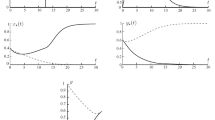Abstract
A mathematical model of tumor growth therapy is considered. The total amount of a drug is bounded and fixed. The problem is to choose an optimal therapeutic strategy, i.e., to choose an amount of the drug permanently affecting the tumor that minimizes the number of tumor cells by a given time. The problem is solved by the dynamic programming method. Exact and approximate solutions to the corresponding Hamilton-Jacobi-Bellman equation are found. An error estimate is proved. Numerical results are presented.
Similar content being viewed by others
References
R. P. Aranjo and D. L. Mcelwain, “A History of the Study of Solid Tumor Growth: The Contribution of Mathematical Modeling,” Bull. Math. Biol. 66, 1039–1091 (2004).
H. M. Byrne, “Using Mathematics to Investigate Solid Tumor Growth,” in Proceedings of 9th International Meeting of European Women in Mathematics (1999), pp. 81–107.
H. M. Byrne, “A Weakly Nonlinear Analysis of a Model of Avascular Solid Tumor Growth,” J. Math. Biol. 39, 151–181 (1999).
A. Matzavinos, M. Chaplain, and V. Kuznetsov, “Mathematical Modeling of the Spatiotemporal Response of Cytotoxic T-Lymphocytes to a Solid Tumor,” Math. Medicine and Biology 21, 1–34 (2004).
C. Guiot, P. G. Degiorgis, P. P. Delsanto, et al., “Does Tumor Growth Follow a ‘Universal Law’,” J. Theor. Biol. 225, 147–151 (2003).
J. D. Murray, Mathematical Biology II: Spatial Models and Biomedical Applications (Springer-Verlag, Berlin, 2003).
A. N. Kolmogorov and S. V. Fomin, Elements of the Theory of Functions and Functional Analysis (Graylock, Rochester, N.Y., 1957/1961; Nauka, Moscow, 1968).
M. I. Costa, J. L. Boldini, and R. C. Bassanezi, “Drug Kinetics and Drug Resistance in Optimal Chemotherapy,” Math. Biosciences 125, 191–209 (1995).
M. I. Costa, J. L. Boldini, and R. C. Bassanezi, “Chemotherapeutic Treatments Involving Drug Resistance and Level of Normal Cells as a Criterion of Toxicity,” Math. Biosciences 125, 211–228 (1995).
J. Hofbauer and K. Sigmund, The Theory of Evolution and Dynamical Systems (Cambridge Univ. Press, New York, 1988).
W. Fleming and R. Rishel, Deterministic and Stochastic Optimal Control (Springer-Verlag, Berlin, 1975).
F. L. Chernous’ko, “Self-Similar Solutions to the Bellman Equation for Optimal Correction of Random Disturbances,” Prikl. Mat. Mekh. 35, 333–342 (1971).
A. S. Bratus’ and K. A. Volosov, “Exact Solutions to Hamilton-Jacoby-Bellman Equation for Problems of Optimal Correction with a Constrained Overall Control Resource,” Prikl. Mat. Mekh. 68, 819–832 (2004).
D. Kirschner and J. C. Panetta, “Modeling Immunotherapy of the Tumor-Immune Interaction,” J. Math. Biol. 37, 235–252 (1998).
T. N. Burden, J. Ernstberger, and K. R. Fister, “Optimal Control Applied to Immunotherapy,” J. Discrete Continuous Dyn. Syst. Ser. 4, 135–146 (2004).
Author information
Authors and Affiliations
Corresponding author
Additional information
Original Russian Text © A.S. Bratus’, E.S. Chumerina, 2008, published in Zhurnal Vychislitel’noi Matematiki i Matematicheskoi Fiziki, 2008, Vol. 48, No. 6, pp. 946–966.
Rights and permissions
About this article
Cite this article
Bratus’, A.S., Chumerina, E.S. Optimal control synthesis in therapy of solid tumor growth. Comput. Math. and Math. Phys. 48, 892–911 (2008). https://doi.org/10.1134/S096554250806002X
Received:
Accepted:
Published:
Issue Date:
DOI: https://doi.org/10.1134/S096554250806002X




